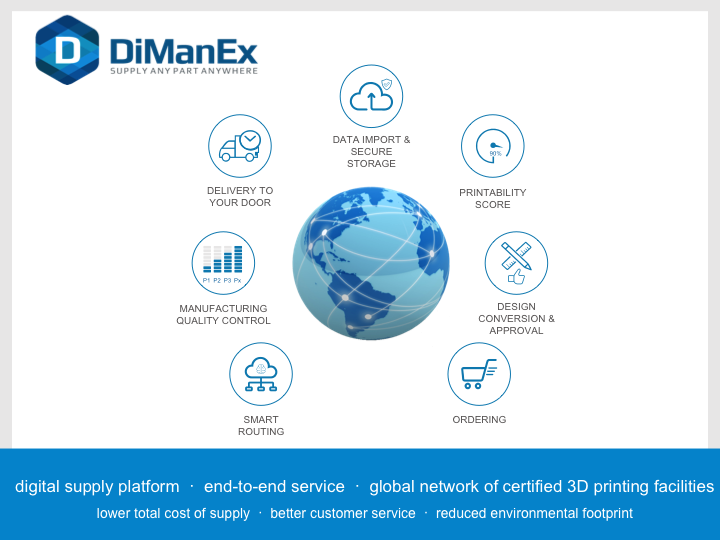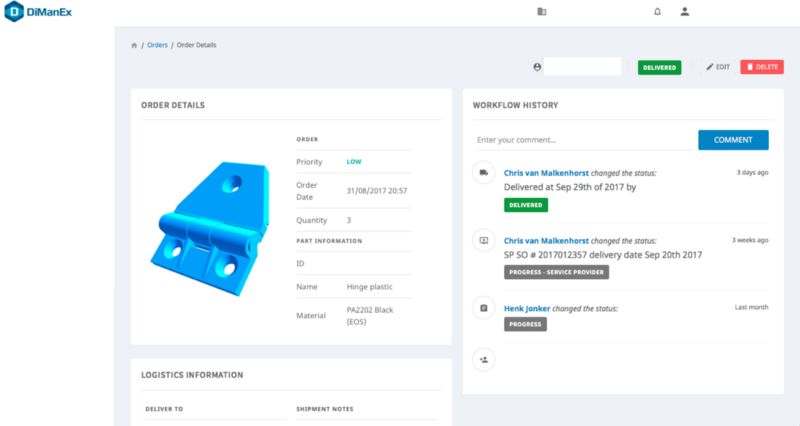This is a guest post in our series looking at the future of 3D Printing. To celebrate 5 years of reporting on the 3D printing industry, we’ve invited industry leaders and 3D printing experts to give us their perspective on the next 5 years of 3D printing.
Tibor van Melsem Kocsis is the CEO of DiManEx. The Netherlands based enterprise focuses on digitization of the supply chain and the use of 3D printing to “revolutionise manufacturing supply chains the same way e-commerce has transformed retail.”
The Future of 3D Printing by Tibor van Melsem Kocsis, CEO of DiManEx
Most supply chain executives might not be fully aware of it, but as Richard D’Aveni states, industrial 3D printing is “about to go mainstream in a big way.” Digital transformation in industrial manufacturing supply chains will be further supported by advances in the speed, cost and quality of 3D printing. Leading companies in industries like aerospace, medical, and automotive have been experimenting with additive manufacturing for years. It won’t be long before other sectors start to catch up.
As the CEO of DiManEx, I have the privilege of seeing this transition happening first hand. 3D printing will soon revolutionize manufacturing supply chains the way e-commerce has transformed retail, and it’s with this ambitious vision in mind that I set out to build DiManEx with my co-founders. DiManEx is a global digital supply platform running on software and smart analytics for distributed 3D manufacturing. We offer an end-to-end service for the on-demand production of parts and small series using a network of industrial quality Additive Manufacturing Partners. Our customers are original equipment manufacturers (OEMs), distributors of industrial components, and other parts-intensive companies.

Manufacturing is becoming more decentralized. Companies that are able to support decentralized manufacturing, both as a service and digitally, will be the ones that benefit most from 3D printing in their supply chain. Until recently, large companies, like GE and Caterpillar, have invested in 3D printing from an R&D point of view. Others, such as big names in the automotive domain, have decided to start producing their own parts in-house, using 3D printing. For most companies, however, buying additive manufacturing equipment does not make sense. The vast majority are already buying parts and outsourcing production to suppliers outside of their own business. In addition, to be able to justify the investment (ROI) in equipment, a 70-80% utilization rate would be required.
I believe we will see widespread adoption of advanced manufacturing techniques like 3D printing within increasingly digitized supply chains, as a service that is cloud-based and controlled. A key factor for widespread adoption is the extent to which legal and IP implications will be adequately addressed, making use of the technology at hand and arrangements within an ecosystem of partners. Successful execution will be spearheaded by providers that excel at IP protection, security, and quality. Using such a service on demand, companies will be able to build up virtual stock libraries to order parts only when and where they are needed. Let’s explore some use cases in detail.

First Series Production, the earliest stage of the manufacturing lifecycle, has been the primary use for 3D printing thus far. In the short-term, maturing technologies in the additive manufacturing space will make prototypes much more functional. Cost savings and shorter lead times will keep compelling companies to look towards 3D printing and related technologies for short series production runs.
Something I expect to see more of in the near future is the use of additive manufacturing for mass customization, especially in consumer goods – where customization can be a significant revenue driver. Consumers are demanding increasingly personalized products. Additive manufacturing allows for shorter production runs and time to market, as well as production near or at the assembly location and unit-level customization. Adidas is one of several companies tapping into 3D printing to deliver customized products. Their Futurecraft 4D will be the first customizable shoe to be mass produced using 3D printing.
When it comes to industry, mass customization will become a means to tune and optimize equipment without huge investments. For example, a sorting machine produced with additive manufacturing could be easily adjusted to sort different kinds of products. Something which would be much more costly and take more time with traditional manufacturing.
Spare and service parts present yet another use case we see maturing and growing in adoption. Manufacturing, storing and shipping spare parts is costly and time intensive. Why stock parts to meet uncertain demand at such a high expense? Building a virtual stock library offers a better way. One of our customers was able to reduce its Total Cost of Ownership for the production of industrial spare and service parts by up to 80% using 3D printing instead of traditional production. Other benefits companies gain by using additive manufacturing for spare parts include better service to customers, higher availability of parts, shorter lead times and lower environmental footprints – as a result of reduced waste and logistics miles traveled.
Besides its obvious benefits to optimize supply chain processes, 3D printing and related technologies will likely create new revenue models. For instance, it’s not hard to imagine industrial companies releasing technical designs for spare parts and letting their customers print them themselves. In such cases, part designs, available online, could be sold based on a pay per use basis. The value for companies would be in the digital file.
Are you ready for it?
The shift to additive manufacturing can have a disruptive impact on your business model, so planning for it and seizing the opportunity soon is crucial. Ask yourself “what should my business strategy be in a world that’s being disrupted by advanced manufacturing and how will this impact my supply chain?” Start experimenting with the technology as part of a digital supply chain, learn through testing and then prepare to institutionalize it. The future is already upon us.
This is a guest post in our series looking at the future of 3D Printing, if you’d like to participate in this series then contact us for more information. For more insights into the 3D printing industry, sign up to our free newsletter and follow our active social media channels.
More information about DiManEx is available here.
Nominations for the 2018 3D Printing Industry Awards are open now, let us know which enterprises are leading.



